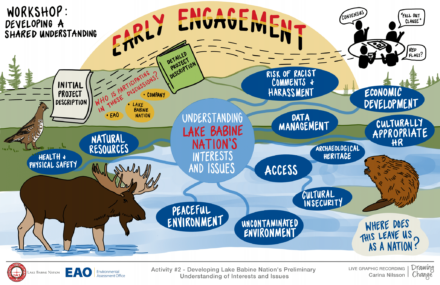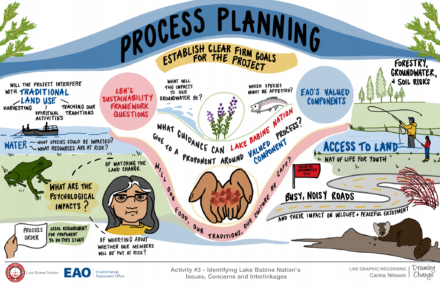Environmental Assessment
Environmental Assessment and the Foundation Agreement
Read our Collaboration Agreement here
Environmental Assessments (EAs) are project reviews to help governments decide whether to approve major projects, like pipelines and large mines. The Province adopted a new and improved EA law in 2018. The new Environmental Assessment Act encourages significant Indigenous participation in EAs. 
Under section 8 of the Foundation Agreement, Lake Babine Nation and British Columbia (BC) have committed to two agreements that are general in scope and not specific to any one project. The first is an EA Collaboration Agreement setting out how Lake Babine and BC will work together in EAs.
The Collaboration Agreement is the first step towards a Lake Babine and BC EA Consent Agreement. The consent agreement will require Lake Babine’s consent for projects in a specified part of Lake Babine Territory; BC would not approve projects without Lake Babine’s consent.
The Collaboration Agreement includes the criteria for Lake Babine decision-making. The criteria that inform Lake Babine’s decision on whether they consent to issuing the EA Certificate under s. 29(2)(c) of the EA Act (2018) are:
- whether the project is sustainable for Lake Babine, its Section 35 Rights and its Territory;
- whether the project includes sufficient and reliable measures to manage any potential negative socio-economic impacts on Lake Babine communities and members;
- whether the project will bring significant benefits to Lake Babine, in keeping with the level of project impacts on Lake Babine, its Section 35 Rights and its Territory; and
- whether the Proponent and Lake Babine are in a respectful relationship that includes significant Lake Babine involvement in the project, in keeping with the nature and level of project impacts on Lake Babine, its Section 35 Rights and its Territory.
An LBN Environmental Assessment Policy
A strong role for Lake Babine in the EA process is not enough: Lake Babine also needs a clear and sound policy on how to decide whether it consents to projects. A policy made by Lake Babine, based on Lake Babine needs, values and responsibilities. Lake Babine’s EA decision-making policy will be included in the Collaboration Agreement. This will help BC and proponents understand what Lake Babine expects of any project proposed in Lake Babine Territory. Proponents will need to start showing whether and how their project meets Lake Babine’s requirements.

For some years now, Lake Babine Chief and Council have required projects to meet the following 4 criteria:
- The project must be sustainable.
- The project must bring significant benefits to LBN, in keeping with the level of project impacts on LBN, niwh be ‘ondzin (LBN rights), and yintah (Territory and the natural resources it sustains).
- The project must include sufficient and reliable measures to manage any potential negative socio-economic impacts on LBN communities and members.
- The proponent and LBN must be in a respectful relationship that includes significant LBN involvement in the project, in keeping with the nature and level of project impacts on LBN, niwh be ‘ondzin, and
More recently, a Lake Babine Nation has developed more detailed frameworks for criteria 1 and 3 to explain what sustainable development means to Lake Babine and to identify the socio-economic impacts that Lake Babine requires proponents to manage effectively.
Lake Babine Nation Sustainability Framework
Lake Babine Nation Socio-economic Impacts Framework
For any questions about the documents, you can contact Councillor Verna Power, or Lake Babine’s legal counsel, Dominique Nouvet: dominique@nouvetlaw.ca
